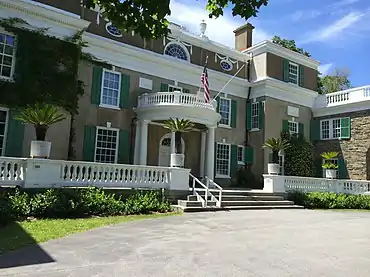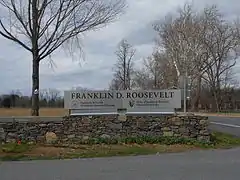Home of Franklin D. Roosevelt National Historic Site
The Home of Franklin D. Roosevelt National Historic Site preserves the Springwood estate in Hyde Park, New York. Springwood was the birthplace, lifelong home, and burial place of the 32nd President of the United States, Franklin D. Roosevelt. The National Historic Site was established in 1945.
Home of Franklin D. Roosevelt National Historic Site | |
 Springwood Estate at Franklin D. Roosevelt National Historic Site. | |
  | |
| Location | Hyde Park, NY |
|---|---|
| Nearest city | Poughkeepsie |
| Coordinates | 41°46′2″N 73°56′8″W |
| Area | 800 acres (3.24 km²) |
| Built | 1800–1845 |
| Architectural style | Federal, Italianate |
| Visitation | 108,611 (2005) |
| Website | Home of Franklin D. Roosevelt National Historic Site |
| NRHP reference No. | 66000056 |
| Significant dates | |
| Added to NRHP | October 15, 1966 |
| Designated NHS | January 15, 1944 |
History of the estate


.jpg.webp)
Early history
In 1697, the English Crown gave a 220 square miles (570 km2) land grant (the "Great Nine Partners Patent") to a group of nine businessmen from New York City. The land extended from the Hudson River on the west to the border with Connecticut on the East. To ensure equal access to the river for all partners, the land on the shore of the river was divided into nine "Water Lots", one of which Springwood was located on and was granted to William Creed, one of the nine partners.
While the early history of the house on the Springwood estate remains unclear, it is believed that the central portion of the present-day house is formed by a large farmhouse that was constructed around the year 1800 in the Federal style. In 1845, the estate was purchased by Josiah Wheeler, a merchant from New York City. Wheeler undertook a remodeling of the house, giving it a then-fashionable Italianate style with a three-story tower at the south end as well as front and rear piazzas spanning the entire length of the house. After this remodeling, the house comprised a total of 15 rooms.
Roosevelt ownership
In 1866, the estate which had been reduced to approximately one square mile (2.5 square kilometers), was bought by James Roosevelt, Franklin D. Roosevelt's father, for US$40,000, at a time when a textile worker's earnings were less than a dollar a day.[1] The property featured a stable and horse track, which was important to James because he took great interest in horse breeding. From the date of purchase until his death 34 years later in 1900, James made many improvements of the house and property. He enlarged the servants' wing of the building, adding two rooms, and had a spacious carriage house built in the vicinity.
In 1882, Franklin was born in what was then the second floor tower bedroom at the south end of the house. At the time, it functioned as the master bedroom; the bedroom which he, and later his sons, used during boyhood is nearby on the same floor. In 1905, after he and Eleanor Roosevelt married, the young couple moved in with his mother. The estate remained the center of Roosevelt's life in all stages of his career.
In 1915, Franklin D. Roosevelt, together with his mother Sara, undertook a final major enlargement and remodeling of the home. This was done in order to accommodate his growing family, but also to create an environment for entertaining his political associates which fitted his ambitions. Roosevelt contributed many ideas for the new design, but since the building work was paid for by his mother Sara, she had to find compromises which also took the financial aspect into account. She commissioned the design work from the firm of Hoppin & Koen, of New York City. The size of the house was more than doubled by adding two large fieldstone wings (designed by Roosevelt), a tower, and a third story with a flat roof. The clapboard exterior of the house was replaced with stucco and most of the porch was replaced with a fieldstone terrace with a balustrade and a small columned portico around the entrance. These alterations gave the exterior of the house the look of a mansion in the Colonial Revival Style. The interior, while retaining much of the layout of the old family home, was redesigned primarily with the aim of housing Roosevelt's growing collections of books, paintings, stamps, and coins. The remodeling work was finished within one year in 1916. Roosevelt also changed the appearance of the surrounding land by extensive planting of trees. Between 1911, when the large scale planting started and Roosevelt's death in 1945, more than 400,000 trees were planted on the estate. Eventually, large portions of the estate were turned into an experimental forestry station under an agreement with the Forestry Department of the Syracuse University.
During his presidency from March 4, 1933 until his death on April 12, 1945, Franklin made almost 200 visits to Springwood, although he eventually built Top Cottage nearby as a home of his own, separate from his mother's. The main estate functioned as a "Summer White House" where the President hosted his political associates as well as other prominent national and international figures. In June 1939, when King George VI and Queen Elizabeth, accompanied by Prime Minister of Canada William Lyon Mackenzie King as minister in attendance,[2] made the first visit of a reigning British monarch to the United States,[3][4][5][6] they were hosted at Springwood. Other guests included Prime Minister of the United Kingdom Winston Churchill, as well as European royalty such as Queen Wilhelmina, Princess Juliana, and Princess Beatrix of the Netherlands, and Crown Prince Olaf and Crown Princess Märtha of Norway. Further, Roosevelt used the estate as a retreat for himself and his political associates on the eves of three of the four elections in which he ran for president. When the incoming results indicated that he had won the election, he would go outside onto the front terrace to deliver his victory speech.
Roosevelt made his last visit to Springwood in the last week of March 1945, about two weeks before his death. At his own wish, he was buried near the sundial in the Rose Garden on April 15, 1945. His wife was buried at his side after her death in 1962. Also buried here are Fala, the famous scottish terrier, and Chief, a German Shepherd also owned by FDR.[7]
Donation to the United States
In 1943—two years before he died in office—Roosevelt donated the estate to the American people under the condition that his family maintained a lifetime right to usage of the property. On November 21, 1945, after the family had relinquished their rights, the estate was transferred to the U.S. Department of the Interior. Since then, the estate has been administered by the National Park Service as a National Historic Site and is open to the public. In 2005, the site covered a total area of more than a square mile and received 108,611 visitors.
Rooms
Entrance Hall
The walls of the entrance hall are mostly covered with pieces from Roosevelt's collection of paintings. On display are mainly naval paintings as well as some historical cartoons. Specimens from his boyhood collection of birds are also on display as well as a sculpture of him when he was 29. In the corner behind the main staircase is a manually operated trunk elevator, which the disabled president used to move between floors.
Living room and library
This room was the place where Roosevelt worked on his private collections; he accumulated a personal library of approximately 14,000 volumes, over 2,000 naval paintings, prints, and lithographs, over 300 bird specimens, over 200 ship models, 1.2 million stamps, as well as thousands of coins, banknotes, campaign buttons, and medallions.
Music room
The music room (also known as the "Dresden Room" for the origin of some of the porcelain) is a formal parlor which contains many Chinese pieces of porcelain and lacquerware. These were acquired when the family of Roosevelt's mother stayed in China, where her father made a fortune in the China trade. Together with the adjacent dining room, this part of the house was the setting for the formal entertaining of guests. A collection of autographed photographs of some of the Roosevelts' more famous guests is kept in the room on the piano.
Bedrooms of Eleanor and Franklin Roosevelt
During the enlargement of the house in 1915, a suite of rooms was created for Eleanor and Franklin Roosevelt in one of the new wings. Originally, these rooms included a sitting room and two dressing rooms, but after Roosevelt contracted a severe paralytic illness in 1921, one of the dressing rooms was converted into a separate bedroom for his wife Eleanor and the sitting room into a bedroom for his mother Sara.
The "Snuggery"
This room was used by Roosevelt's mother, Sara, for beginning her day and conducting her business of running the household. The room was created in its present form during the extensive remodeling of 1915 by a division of the old South Parlor into a gallery and the Snuggery. Because most of the furniture of the old parlor was retained despite the reduction in size, the Snuggery has a cluttered appearance.
Gallery
 Entrance to the FDR National Historic Site
Entrance to the FDR National Historic Site South hallway on the main floor, leading into the living-room, with a view of the Snuggery door to the left
South hallway on the main floor, leading into the living-room, with a view of the Snuggery door to the left Statue of Roosevelt as a young man
Statue of Roosevelt as a young man Library and living room
Library and living room FDR's childhood bedroom
FDR's childhood bedroom Horse stable
Horse stable Outbuildings
Outbuildings Side of Springwood
Side of Springwood
See also
References
- Notes
- "Archived copy" (PDF). Archived (PDF) from the original on 2017-10-31. Retrieved 2018-03-09.CS1 maint: archived copy as title (link), page 476
- King, William Lyon Mackenzie, Diary of Mackenzie King, Ottawa: Queen's Printer for Canada, pp. 377, 413–414, 533–685, 17 May 1939, archived from the original on 2012-10-18
- Bousfield, Arthur; Toffoli, Gary (1989). Royal Spring: The Royal Tour of 1939 and the Queen Mother in Canada. Toronto: Dundurn Press. pp. 60, 66. ISBN 1-55002-065-X.
- Lanctot, Gustave (1964). Royal Tour of King George VI and Queen Elizabeth in Canada and the United States of America 1939. Toronto: E.P. Taylor Foundation.
- King 1939, pp. 247
- Bell, Peter (October 2002), "The Foreign Office and the 1939 Royal Visit to America: Courting the USA in an Era of Isolationism" (PDF), Journal of Contemporary History, 37 (4): 603, 611, doi:10.1177/00220094020370040601, archived from the original (PDF) on July 25, 2011, retrieved August 30, 2010
- "Memorials in Franklin D. Roosevelt National Historic Site - Find A Grave". www.findagrave.com. Archived from the original on 22 July 2017. Retrieved 3 May 2018.
- Sources
- Springwood: birthplace of Franklin Delano Roosevelt. Photography by Richard Cheek, text by Franklin D. Mares. Hyde Park Historical Association, Hyde Park, NY, 1993.
Further reading
- Great Houses of the Hudson River, Michael Middleton Dwyer, editor, with preface by Mark Rockefeller, Boston, MA: Little, Brown and Company, published in association with Historic Hudson Valley, 2001. ISBN 082122767X.
External links
| Wikimedia Commons has media related to Springwood (New York). |
- Home of Franklin D. Roosevelt National Historic Site - National Park Service
- "Springwood: Birthplace and Home to Franklin D. Roosevelt", a National Park Service Teaching with Historic Places lesson plan
- "Life Portrait of Franklin D. Roosevelt", from C-SPAN's American Presidents: Life Portraits, broadcast from the home of Franklin D. Roosevelt National Historic Site and the Franklin D. Roosevelt Presidential Library and Museum, October 11, 1999
